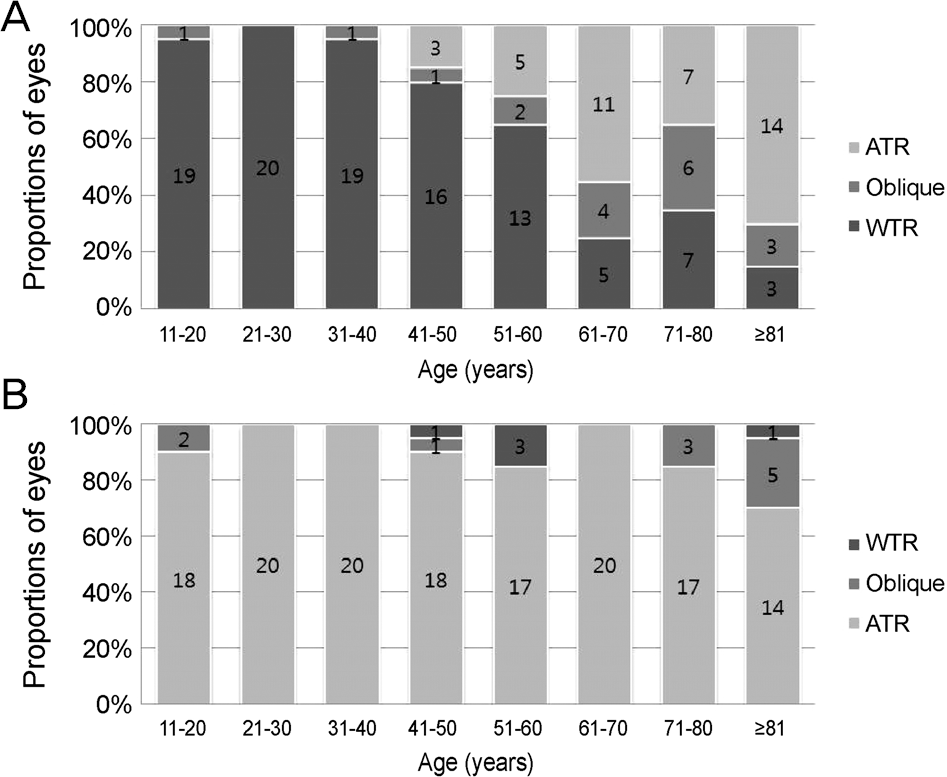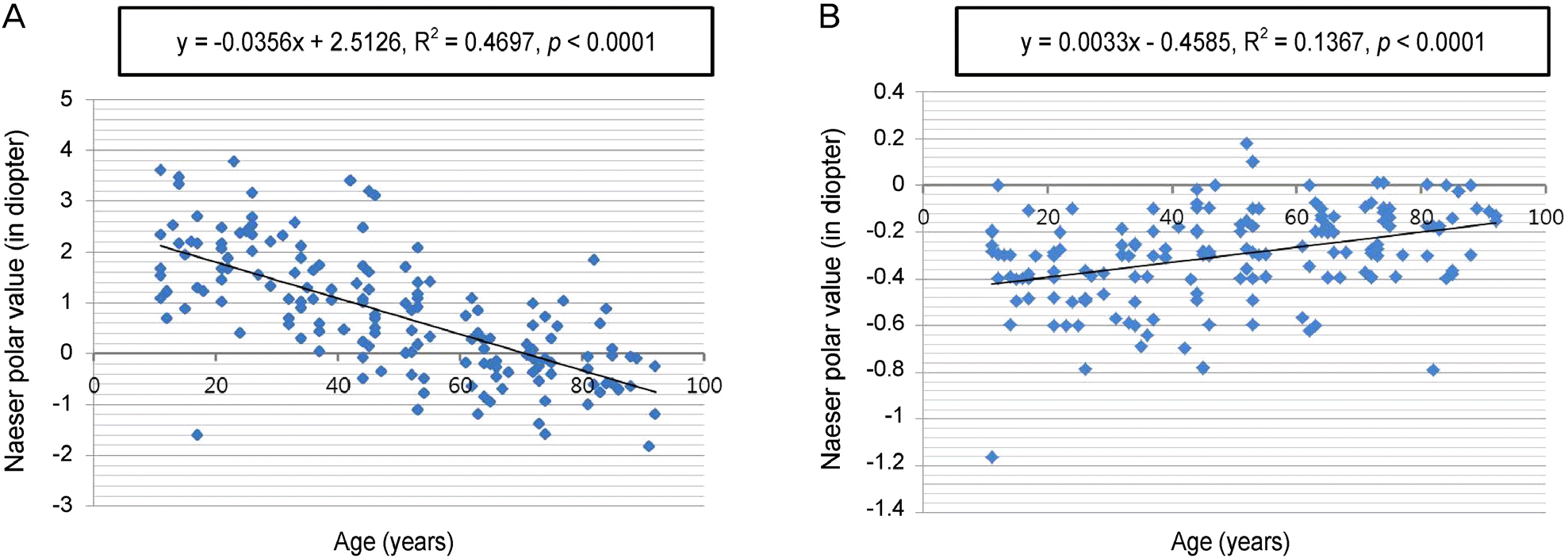Abstract
Methods
The anterior and posterior corneal astigmatisms of 160 subjects with age ranging from 11 to 92 years, none of whom experienced any complications, were measured with a rotating Scheimpflug camera (Pentacam®). Using this data, the changing proportions of with-the-rule to against-the-rule and changing tendency of anterior and posterior corneal astigmatisms with age were evaluated using polar value analysis according to the Naeser method.
Results
For the anterior cornea, the proportion of with-the-rule astigmatisms decreased with age (p < 0.0001). On the other hand, for the posterior cornea, the proportion of against-the-rule astigmatisms decreased with age (p = 0.012). In the polar value analysis, there was a trend toward against-the-rule astigmatism associated with increasing age for the anterior cornea (p < 0.0001) and toward with-the-rule astigmatism for the posterior cornea (p < 0.0001).
Conclusions
In previous studies, the anterior corneal surface shifted from with-the-rule to against-the-rule astigmatism with in-creasing age, whereas the posterior corneal surface remained as against-the-rule astigmatism in most cases. But, our results showed that the proportion of against-the-rule astigmatisms of the posterior cornea decreased with age. Thus, evaluation of pos-terior corneal astigmatisms should be performed before cataract surgery in old patients, especially when using a multifocal or toric intraocular lens.
Go to : 
References
1. Kim CS, Kim M, Kim HS, Lee YC. Change of corneal astigmatism with aging in Koreans with normal visual acuity. J Korean Ophthalmol Soc. 2002; 43:1956–62.
2. Han JM, Choi HJ, Kim MK. . Comparative analysis of corneal refraction and astigmatism measured with Autokeratometer, IOL Master, and Topography. J Korean Ophthalmol Soc. 2011; 52:1427–33.

3. Koch DD, Ali SF, Weikert MP. . Contribution of posterior cor-neal astigmatism to total corneal astigmatism. J Cataract Refract Surg. 2012; 38:2080–7.

4. Reitblat O, Levy A, Kleinmann G. . Effect of posterior corneal astigmatism on power calculation and alignment of toric intra-ocular lenses: comparison of methodologies. J Cataract Refract Surg. 2016; 42:217–25.

5. Cheng LS, Tsai CY, Tsai RJ. . Estimation accuracy of surgi-cally induced astigmatism on the cornea when neglecting the pos-terior corneal surface measurement. Acta Ophthalmol. 2011; 89:417–22.

6. Miyake T, Shimizu K, Kamiya K. Distribution of posterior corneal astigmatism according to axis orientation of anterior corneal astigmatism. PLoS One. 2015; 10:e0117194.

7. Ueno Y, Hiraoka T, Beheregaray S. . Age-related changes in anterior, posterior, and total corneal astigmatism. J Refract Surg. 2014; 30:192–7.

8. Lim TH, Lee JR, Choi KY, Cho BJ. Anterior and posterior corneal spherical aberration measured with Pentacam in the Korean. J Korean Ophthalmol Soc. 2010; 51:816–21.

9. Ho JD, Liou SW, Tsai RJ, Tsai CY. Effects of aging on anterior and posterior corneal astigmatism. Cornea. 2010; 29:632–7.

10. Naeser K. Conversion of keratometer readings to polar values. J Cataract Refract Surg. 1990; 16:741–5.

11. Ho JD, Tsai CY, Liou SW. Accuracy of corneal astigmatism esti-mation by neglecting the posterior corneal surface measurement. Am J Ophthalmol. 2009; 147:788–95. 795.e1-2

12. Kim CS, Ryu JW, Kim HS, Lee YC. Distribution and change of to-tal astigmatism, corneal astigmatism and residual astigmatism with age in patient with emmetropia. J Korean Ophthalmol Soc. 2005; 46:485–93.
14. Howland HC, Sayles N. Photokeratometric and photorefractive measurements of astigmatism in infants and young children. Vision Res. 1985; 25:73–81.
15. Hayashi K, Hayashi H, Hayashi F. Topographic analysis of the changes in corneal shape due to aging. Cornea. 1995; 14:527–32.

16. Koch DD, Jenkins RB, Weikert MP. . Correcting astigmatism with toric intraocular lenses: effect of posterior corneal astigmatism. J Cataract Refract Surg. 2013; 39:1803–9.

Go to : 
 | Figure 1.Distributions of different kinds of astigmatism by age group. (A) The anterior cornea, The proportions of with-the rule astigmatisms are 95% in the 11–20 age group and 15% in the ≥81 age group. (B) The posterior cornea, The pro-portions of with-the-rule astigmatisms are 0% in the 11–20 age group and 5% in the ≥71 age group. ATR = against the rule; WTR = with the rule. |
 | Figure 2.Scattergrams of polar values described by Naeser (in diopter) versus age and the linear regression model. (A) The anterior corneal astigmatisms showed a significant against-the-rule change with age. The average change in against-the-rule astigmatism ev-ery 10 years was 0.356 D. On the other hand, (B) The posterior corneal astigmatism displayed with-the-rule changes with age with an average. The average change in with-the-rule astigmatism every 10 years was 0.033 D. |




 PDF
PDF ePub
ePub Citation
Citation Print
Print


 XML Download
XML Download